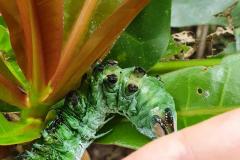You’ll forget everything you know about large caterpillars, once you see one of those! It is unreal, they look a bit like a plastic toy. To me the caterpillar looked dead, because of the white waxy surface and the fact that it was upside down. It moved slowly when I took the picture, so I think it was ok, but maybe about the spin a cocoon.
The Atlas moth is one of the largest moths on our planet. But what does that mean? Usually we would equal large with impressive, may it be the wingspan, the weight or the surface area of the wings.
There are the Hercules moth, Coscinocera hercules, as well as Thysania agrippina, the White witch, with similar dimensions as the Atlas moth. Here is a comparison of all three. The numbers for their dimensions vary from source to source, and for sure the size is a variable itself. That’s nature! So why don’t we take it easy and let several species be the largest?! Queen Alexandra’s birdwing by the way seems to be the largest butterfly in the world. Each four are impressive insects.
Hard to believe, the White witch is or was for the longest time only known as moth, but not as larvae. They must live in a remote area, while the moths travel far and can be seen frequently. The before mentioned German, Maria Sibylla Merian, has drawn it in Surinam 300+ years ago, and might have caused some additional confusion, because it turned out to be a different species what she called White witch. There is a project called the White witch watch (great name!) to learn about the life cycle of the White witch. Still a lot to study in the world of bugs in 2021!
At least A. atlas and C. hercules have in common that they won’t live long once they hatched as moth. Two weeks would already be old. They don’t even have working mouths, so they cannot eat at all as moth. What a change in lifestyle, from never-not-eating as caterpillar to not-eating-at-all. Here is a detailed description of their lifecycle.
